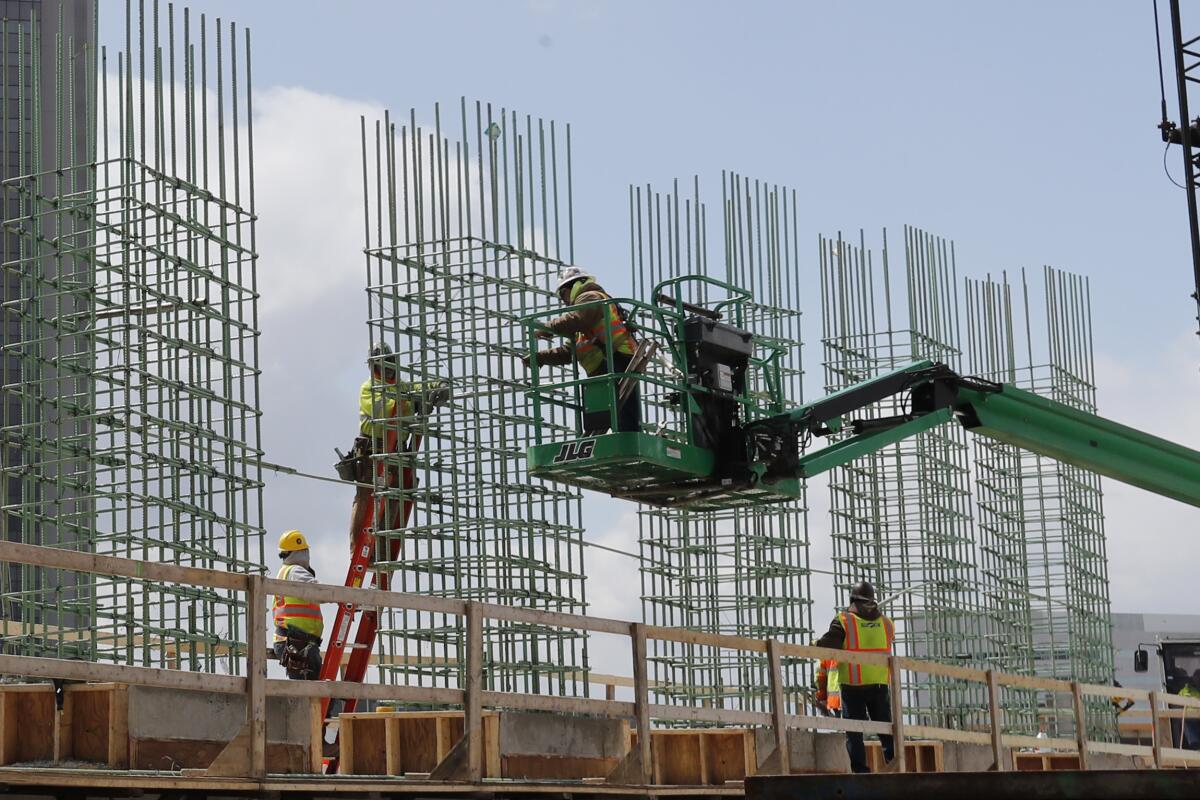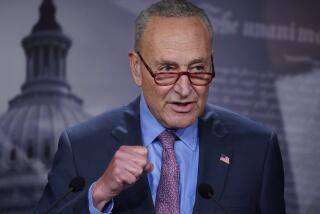Biden team readies wider economic package after coronavirus relief

- Share via
WASHINGTON — Looking beyond the $1.9-trillion COVID-19 relief bill, President Biden and lawmakers are laying the groundwork for another top legislative priority — a long-sought boost to the nation’s roads, bridges and other infrastructure that could run into Republican resistance to a hefty price tag.
Biden and his team have begun discussions on the possible outlines of an infrastructure package with members of Congress, particularly mindful that Texas’ recent struggles with power outages and water shortages after a brutal winter storm present an opportunity for agreement on sustained spending on infrastructure.
Republicans say if the White House approach on the COVID-19 relief bill — which passed the House on Saturday on a near party-line vote and now heads to the Senate — is a sign of things to come for Biden’s plan on infrastructure and other initiatives, it could be a difficult road ahead in Congress.
Some 80,000 Mexicans have disappeared in the last 15 years. Many are now thought to be in government custody — among the thousands of corpses that pass through morgues each year without ever being identified and end up in common graves.
A White House proposal could come out in March.
“Now is the time to be aggressive,” said Transportation Secretary Pete Buttigieg, a former South Bend, Ind., mayor who knows potholes.
At a conference with state and local highway officials Thursday, he referred to the often-promised, never-achieved mega-initiative on roads, bridges and the like from the Trump administration.
“I know you are among those who are working and waiting most patiently, or maybe impatiently, for the moment when Infrastructure Week will no longer be a kind of Groundhog’s Day promise, but actually be something that delivers generational investments,” he said.
Much of America’s infrastructure — roads, bridges, public drinking and water systems, dams, airports, mass transit systems and more — is in need of major restoration after years of underfunding, according to the American Society of Civil Engineers. In its 2017 Infrastructure Report Card, it gave the national infrastructure an overall grade of D-plus.
Both chambers of Congress will use as starting points their unsuccessful efforts to get infrastructure bills through the last session.
Democrats passed a $1.5-trillion package in the House last year, but it went nowhere with the Trump administration and the Republican-led Senate. A Senate panel approved narrower bipartisan legislation in 2019 focused on reauthorizing federal transportation programs. It too flamed out as the U.S. turned its focus to elections and COVID-19.
Biden has talked bigger numbers, and some Democrats are urging him to bypass Republicans in the closely divided Congress to address a broader range of priorities urged by interest groups.
During the presidential campaign, Biden pledged to deploy $2 trillion on infrastructure and clean energy, but the White House has not ruled out an even higher price tag.
Pointing to the storm in Texas as a “wake-up call” for the need to improve energy systems and other infrastructure, Gina McCarthy, Biden’s national climate advisor, said Biden’s plan will specifically aim at green and other initiatives that promote job creation. She cited as an example federal investments to boost “workers that have been left behind” by closed coal mines or power plants, as well as communities near polluting refineries and other hazards.
“He’s been a long fan of investing in infrastructure — long outdated — long overdue, I should say,” White House Press Secretary Jen Psaki said Thursday. “But he also wants to do more on caregiving, help our manufacturing sector, do more to strengthen access to affordable healthcare. So the size — the package — the components of it, the order, that has not yet been determined.”
Sen. Bernie Sanders (I-Vt.), chairman of the Senate Budget Committee, recently told the White House that he’s ready to use the budget maneuver known as reconciliation to pass a broad economic recovery package with only Democratic votes. That drew stern warnings from Republicans, who have already closed ranks against Democrats’ COVID-19 relief bill.
“They made a conscious decision not to include us,” said Sen. Bill Cassidy (R-La.) on Sunday, calling the White House’s assertion that the views of Republicans were taken into account with the COVID-19 bill a “joke.”
Cassidy, one of 10 centrist Republicans who met with Biden in early February about getting bipartisan support on that bill, said Biden “so far has been about rhetoric” when it comes to his pledge of seeking unity and bipartisanship. He called it worrisome for other legislative initiatives.
“Republicans remain willing and are working on issues that require bipartisan cooperation,” he told CNN’s “State of the Union.”
West Virginia Sen. Shelley Moore Capito, a Republican who will be helping to craft legislation on the Senate side, said there’s bipartisan support for ambitious steps on infrastructure. But that “should not extend to a multitrillion-dollar package that is stocked full with other ideologically driven, one-size-fits-all policies that tie the hands of our states and our communities,” said Capito, the ranking member on the Senate Environment and Public Works Committee.
Rep. Peter A. DeFazio, chairman of the House Transportation and Infrastructure Committee, said he foresees a comprehensive House package that will go beyond roads, bridges and public transit. He also expects it to have money for water systems, broadband and the power grid — addressing a weak infrastructure laid bare after the crippling blackouts in Texas.
He’s not ready to talk overall costs yet. DeFazio (D-Ore.) said it will be up to the Biden administration and the House Ways and Means Committee to figure out how to pay for it.
DeFazio said General Motors’ recently announced goal of going largely electric by 2035 demonstrates the need for massive spending on charging stations across the country. Biden campaigned on a plan to install 500,000 charging stations by the end of 2030.
“I’m totally willing to work with [Republicans] if they’re willing to recognize climate change,” DeFazio said, “or if they don’t want to recognize climate change, they can just recognize that electric semis and electric vehicles are a flood on the horizon and we’ve got to get ahead of it.”
Democratic Michigan Gov. Gretchen Whitmer expressed a similar sentiment, urging strong action on carbon emissions and the vehicle charging stations to help achieve a “full transition to electric.” She also wants states to have more federal grants for infrastructure repairs after natural disasters and extreme weather.
At the Senate hearing where she spoke, Republican Gov. Larry Hogan of Maryland said there’s bipartisan support among governors for relieving congestion, cutting red tape, leveraging private-sector investment and ensuring projects can better withstand cyberattacks and natural disasters.
Democratic Sen. Thomas R. Carper of Delaware, the new chairman of the Senate Environment and Public Works Committee, said his goal is for his committee to pass an infrastructure bill by Memorial Day.
In the House, Rep. Sam Graves of Missouri, the top Republican on the transportation panel, said Republicans would be open to a larger package as long as it didn’t greatly add to the national debt.
But many lawmakers oppose an increase in the federal gas tax, one way to help pay for the spending, while groups such as the U.S. Chamber of Commerce argue against increasing taxes on companies during a pandemic.
White House aide Cedric Richmond, a former congressman from Louisiana, told state transportation officials the president intends for most of the spending to be paid for, not added to the debt. In part, this would be by reversing some of the Trump administration tax cuts.
Ed Mortimer, a vice president at the Chamber of Commerce, said removing items in last year’s infrastructure bill for renovating schools and low-income housing could lower the price tag, because the COVID-19 relief measure passed by the House already has hundreds of billions of dollars for those purposes.
“Affordable housing, school construction, very meritorious, but we’re not sure that that’s a key focus that’s going to get a bill signed into law,” Mortimer said.
More to Read
Sign up for Essential California
The most important California stories and recommendations in your inbox every morning.
You may occasionally receive promotional content from the Los Angeles Times.











